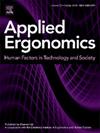Secular trends in facial anthropometry among Chilean workers: Implications for ergonomic respirator design and fit panel adaptation
IF 3.4
2区 工程技术
Q2 ENGINEERING, INDUSTRIAL
引用次数: 0
Abstract
The ergonomic fit of respiratory protective equipment (RPE) is critical for ensuring both protection and long-term usability in occupational settings. However, most respirators are designed based on outdated or foreign anthropometric data that may not represent local populations. In Chile, as in many countries without updated national databases, this mismatch can compromise comfort, effectiveness, and user compliance. This study evaluated temporal changes in facial dimensions among Chilean workers and assessed the applicability of four widely used respirator fit test panels. Two representative datasets collected a decade apart were analyzed: Dataset A (n = 474; 2013) with manual measurements, and Dataset B (n = 2016; 2024) using 3D facial scanning. Eleven facial dimensions recommended by ISO standards were examined against the LANL half- and full-facepiece panels and the NIOSH/ISO bivariate and PCA panels. Results showed significant increases in facial size, particularly among men, and a general shift toward larger facial morphologies. The NIOSH/ISO bivariate panel provided the highest coverage, while the LANL full-facepiece panel showed the poorest fit, especially among recent male participants. Gender-based differences in fit were consistent across both datasets. These findings underscore the need for updated, population-specific anthropometric references and the ergonomic redesign of respirators and fit panels. Although centered on Chile, the study has global relevance for countries that import RPE without validating fit locally. The methodology offers a scalable approach for aligning protective equipment with evolving worker characteristics, supporting international efforts to improve comfort, safety, and usability through data-informed design. These declining match rates suggest that respirator fit panels may become increasingly outdated, potentially compromising worker safety if they are not updated to reflect current population characteristics.
智利工人面部人体测量的长期趋势:对人体工程学呼吸器设计和适应面板的影响
符合人体工程学的呼吸防护设备(RPE)对确保职业环境中的保护和长期可用性至关重要。然而,大多数呼吸器是根据过时的或国外的人体测量数据设计的,这些数据可能无法代表当地人口。在智利,与许多没有更新国家数据库的国家一样,这种不匹配可能会影响舒适度、有效性和用户依从性。本研究评估了智利工人面部尺寸的时间变化,并评估了四种广泛使用的呼吸器适配测试面板的适用性。对相隔十年收集的两个代表性数据集进行了分析:数据集a (n = 474;数据集B (n = 2016;2024年)使用3D面部扫描。根据ISO标准推荐的11个面部尺寸对LANL半面和全面面板以及NIOSH/ISO双变量和PCA面板进行了检查。结果显示,面部尺寸显著增加,尤其是男性,面部形态普遍向更大的方向转变。NIOSH/ISO双变量面板提供了最高的覆盖率,而LANL全面罩面板显示最不适合,特别是在最近的男性参与者中。基于性别的拟合差异在两个数据集中是一致的。这些发现强调了更新的、针对特定人群的人体测量参考资料以及对呼吸器和适配板进行人体工程学重新设计的必要性。尽管该研究以智利为中心,但对于那些进口RPE而不验证当地适用性的国家来说,该研究具有全球相关性。该方法提供了一种可扩展的方法,使防护设备与不断变化的工人特征保持一致,通过数据知情的设计,支持国际努力提高舒适性、安全性和可用性。这些下降的匹配率表明,如果口罩适配板不更新以反映当前的人口特征,它们可能会变得越来越过时,可能会危及工人的安全。
本文章由计算机程序翻译,如有差异,请以英文原文为准。
求助全文
约1分钟内获得全文
求助全文
来源期刊

Applied Ergonomics
工程技术-工程:工业
CiteScore
7.50
自引率
9.40%
发文量
248
审稿时长
53 days
期刊介绍:
Applied Ergonomics is aimed at ergonomists and all those interested in applying ergonomics/human factors in the design, planning and management of technical and social systems at work or leisure. Readership is truly international with subscribers in over 50 countries. Professionals for whom Applied Ergonomics is of interest include: ergonomists, designers, industrial engineers, health and safety specialists, systems engineers, design engineers, organizational psychologists, occupational health specialists and human-computer interaction specialists.
 求助内容:
求助内容: 应助结果提醒方式:
应助结果提醒方式:


